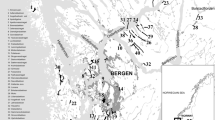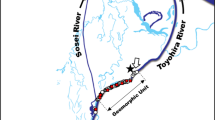Abstract
Winter concealment habitat quality was assessed and its use by juvenile spring Chinook salmon (Oncorhynchus tshawytscha) quantified in three hatching areas of the Grande Ronde River Basin, Oregon USA. Fish densities were significantly higher in pools with a higher winter concealment habitat index than pools with a lower index. The mean fork length and mean growth rate of fish did not differ between pools with a higher or lower winter concealment habitat index, even though residual fish were significantly larger than fish that emigrated. Biomass–density was significantly higher in pools with a higher winter concealment habitat index than pools with a lower index in all three hatching areas. Biomass–density was positively associated with the amount of cobble substrate (10–24.9 cm/m2) in all three hatching areas, and inversely associated with embeddedness in two of the hatching areas. Results of this study indicate that enhancing winter concealment habitat could improve habitat quality resulting in increased carrying capacity and winter usage by juvenile spring Chinook salmon.





Similar content being viewed by others
References
Armstrong, J. D., 1997. Self-thinning in juvenile sea trout and other salmonid fishes revisited. Journal of Animal Ecology 66: 519–526.
Armstrong, J. D. & S. W. Griffiths, 2001. Density-dependent refuge use among over-wintering wild Atlantic salmon juveniles. Journal of Fish Biology 58: 1524–1530.
Bain, M. B. & N. J. Stevenson, 1999. Aquatic Habitat Assessment: Common Methods. American Fisheries Society, Bethesda, Maryland.
Bjornn, T. C., 1971. Trout and salmon movements in two Idaho streams as related to temperature, food, stream flow, cover, and population density. Transactions of the American Fisheries Society 100: 423–438.
Bustard, D. R. & D. W. Narver, 1975. Aspects of the winter ecology of juvenile coho salmon (Oncorhynchus kisutch) and steelhead trout (Salmo gairdneri). Journal of the Fisheries Research Board of Canada 32: 667–680.
Chandler, G. L. & T. C. Bjornn, 1988. Abundance, growth, and interaction of juvenile steelhead relative to time of emergence. Transactions of the American Fisheries Society 117: 432–443.
Chapman, D. W., 1962. Aggressive behavior in juvenile coho salmon as a cause of emigration. Journal of the Fisheries Research Board of Canada 19: 1047–1080.
Chapman, D. W. & T. C. Bjornn, 1969. Distribution of salmonids in streams, with special reference to food and feeding. In Northcote, T. G. (ed.), Symposium on salmon and trout in streams. H.R. MacMillan Lectures in Fisheries, University of British Columbia, Vancouver, B.C.: 153–176.
Cunjak, R. A., 1988. Behaviour and microhabitat of young Atlantic salmon (Salmo salar) during winter. Canadian Journal of Fisheries and Aquatic Sciences 45: 2156–2160.
Edmundson, E., F. E. Everest & D. W. Chapman, 1968. Permanence of station in juvenile Chinook salmon and steelhead trout. Journal of the Fisheries Research Board of Canada 25: 1453–1464.
Elliott, J. M., 1986. Spatial dispersion and behavioural movements of migratory trout Salmo trutta in a Lake District stream. Journal of Animal Ecology 55: 907–922.
Elliott, J. M., 1993. The self-thinning rule applied to juvenile sea-trout, Salmo trutta. Journal of Animal Ecology 62: 371–379.
Everest, F. H. & D. W. Chapman, 1972. Habitat selection and spatial interaction by juvenile Chinook salmon and steelhead trout in two Idaho streams. Journal of the Fisheries Research Board of Canada 29: 91–100.
Fausch, K. D. & R. J. White, 1986. Competition among juvenile coho salmon, and brown trout in a laboratory stream, and implications for Great Lakes tributaries. Transactions of the American Fisheries Society 115: 363–381.
Fore, L. S., 2003. Developing biological indicators: lessons learned from Mid-Atlantic streams. U.S. Environmental Protection Agency 903/R-003/003. Fort Meade, Maryland, USA.
Fréchette, M. & D. Lefaivre, 1995. On self-thinning in animals. Oikos 73: 425–428.
Grant, J. W. A. & D. L. Kramer, 1990. Territory size as a predictor of the upper limit to population density of juvenile salmonids in streams. Canadian Journal of Fisheries and Aquatic Sciences 47: 1724–1737.
Griffith, J. S. & R. W. Smith, 1993. Use of winter concealment cover by juvenile cutthroat and brown trout in the South Fork of the Snake River, Idaho. North American Journal of Fisheries Management 13: 823–830.
Hartman, G. F., 1965. The role of behavior in the ecology and interaction of underyearling coho salmon (Oncorhynchus kisutch) and steelhead trout (Salmo gairdneri). Journal of the Fisheries Research Board of Canada 22: 1035–1079.
Harwood, A. J., N. B. Metcalfe, S. W. Griffiths & J. C. Armstrong, 2002. Intra- and inter-specific competition for winter concealment habitat in juvenile salmonids. Canadian Journal of Fisheries and Aquatic Sciences 59: 1515–1523.
Heggenes, J., O. M. W. Krog, O. R. Lindås, J. G. Dokk & T. Bremnes, 1993. Homeostatic behavioural responses in a changing environment: brown trout (Salmo trutta) become nocturnal during winter. Journal of Animal Ecology 62: 295–308.
Hillman, T. W., J. S. Griffith & W. S. Platts, 1987. Summer and winter habitat selection by juvenile Chinook salmon in a highly sedimented Idaho stream. Transactions of the American Fisheries Society 116: 185–195.
Hughes, R. N. & C. L. Griffiths, 1988. Self-thinning in barnacles and mussels: the geometry of packing. The American Naturalist 118: 581–587.
Jaeger, R. G., 1974. Competitive exclusion: comments on survival and extinction of a species. BioScience 24: 33–39.
Jonasson, B. C., J. V. Tranquilli, P. M. Sankovich, E. S. Van Dyke, M. Keefe & R. W. Carmichael, 1999. Investigations into the early life history of naturally produced spring Chinook salmon in the Grande Ronde River Basin. Oregon Department of Fish and Wildlife. Annual Progress Report to Bonneville Power Administration, Portland, Oregon.
Keeley, E. R., 2001. Demographic responses to food and space competition by juvenile steelhead trout. Ecology 82: 1247–1259.
Keeley, E. R. & J. D. McPhail, 1998. Food abundance, intruder pressure, and body size as determinants of territory size in juvenile steelhead trout (Oncorhynchus mykiss). Behaviour 135: 65–82.
Kruzic, L. M., D. L. Scarnecchia & B. B. Roper, 2001. Comparison of midsummer survival and growth of age-0 hatchery coho salmon held in pools and riffles. Transactions of the American Fisheries Society 130: 147–154.
Lister, D. B. & H. S. Genoe, 1970. Stream habitat utilization by cohabiting underyearlings of Chinook (Oncorhynchus tshawytscha) and coho salmon (O. kisutch) in the Big Qualicum River, British Columbia, Canada. Journal of the Fisheries Research Board of Canada 27: 1215–1224.
Mason, J. C. & D. W. Chapman, 1965. Significance of early emergence, environmental rearing capacity, and behavioral ecology of juvenile coho salmon in stream channels. Journal of the Fisheries Research Board of Canada 22: 173–190.
McIntosh, B. A., J. R. Sedell, J. E. Smith, R. C. Wissmar, S. E. Clarke, G. H. Reeves & L. A. Brown, 1994. Management History of Eastside Ecosystems: Changes in Fish Habitat Over 50 Years, 1935 to 1992. U.S. Department of Agriculture, Forest Service, General Technical Report PNW-GRT-321, Portland, Oregon.
Meyer, K. A. & J. S. Griffith, 1997. Effects of cobble-boulder substrate configuration on winter residency of juvenile rainbow trout. North American Journal of Fisheries Management 17: 77–84.
Nowak, M. C., 2004. Grande Ronde Subbasin Plan. Prepared for the Northwest Power and Conservation Council, Portland, Oregon.
Platts, W. S., W. F. Megahan & G. W. Minshall, 1983. Methods for Evaluating Stream, Riparian and Biotic Conditions. U.S. Forest Service, Inter-mountain Forest and Range Experiment Station, General Technical Report INT-138, Ogden, Utah.
Prentice, E. F., T. A. Flagg, C. S. McCutcheon, D. F. Brastow & D. C. Cross, 1990. Equipment, methods, and an automated data-entry station for PIT tagging. American Fisheries Society Symposium 7: 335–340.
Quinn, T. P. & N. P. Peterson, 1996. The influence of habitat complexity and fish size on over-winter survival and growth of individually marked juvenile coho salmon (Oncorhynchus kisutch) in Big Beef Creek, Washington. Canadian Journal of Fisheries and Aquatic Sciences 53: 1555–1564.
Riehle, M. D. & J. S. Griffith, 1993. Changes in habitat use and feeding chronology of juvenile rainbow trout (Oncorhynchus mykiss) in fall and the onset of winter in Silver Creek, Idaho. Canadian Journal of Fisheries and Aquatic Sciences 50: 2119–2128.
SAS Institute Inc, 1999. SAS User’s Guide: Statistics, Version 8 Edition. SAS Institute Inc, Cary, North Carolina.
Seaber, P. R., F. P. Kapinos & G. L. Knapp, 1987. Hydrologic Unit Maps. U.S. Geologic Survey Water-Supply Paper 2294, Denver, Colorado.
Seber, G. A. F., 1982. The Estimation of Animal Abundance and Related Parameters, 2nd ed. The Blackburn Press, Caldwell, New Jersey.
Steingrímsson, S. Ó. & J. W. A. Grant, 1999. Allometry of territory size and metabolic rate as predictors of self-thinning in young-of-the-year Atlantic salmon. Journal of Animal Ecology 68: 17–26.
Taylor, E. B., 1988. Water temperature and velocity as determinants of microhabitats of juvenile Chinook and coho salmon in a laboratory stream channel. Transactions of the American Fisheries Society 117: 22–28.
Van Den Avyle, M. J. & R. S. Hayward, 1999. Dynamics of exploited fish populations. In Kohler, C. C. & W. A. Hubert (eds), Inland Fisheries Management in North America, 2nd ed. American Fisheries Society, Bethesda, Maryland: 127–166.
Weller, D. E., 1987. Self-thinning exponent correlated with allometric measures of plant geometry. Ecology 68: 813–821.
Westoby, M., 1981. The place of the self-thinning rule in population dynamics. The American Naturalist 118: 581–587.
Acknowledgments
We would like to express our sincerest appreciation to the staff of the Salmonid Early Life History Project for braving late nights in cold inclement conditions to acquire the information necessary to complete this manuscript. This research was supported by Oregon Department of Fish and Wildlife through funding from Bonneville Power Administration.
Author information
Authors and Affiliations
Corresponding author
Additional information
Handling editor: J. A. Cambray
Electronic Supplementary Material
Rights and permissions
About this article
Cite this article
Van Dyke, E.S., Scarnecchia, D.L., Jonasson, B.C. et al. Relationship of winter concealment habitat quality on pool use by juvenile spring Chinook salmon (Oncorhynchus tshawytscha) in the Grande Ronde River Basin, Oregon USA. Hydrobiologia 625, 27–42 (2009). https://doi.org/10.1007/s10750-008-9684-6
Received:
Revised:
Accepted:
Published:
Issue Date:
DOI: https://doi.org/10.1007/s10750-008-9684-6




